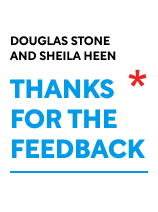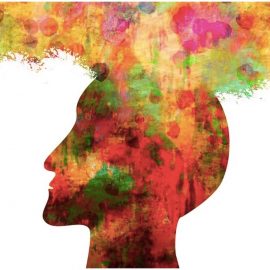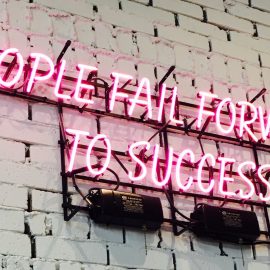

This article is an excerpt from the Shortform book guide to "Thanks for the Feedback" by Douglas Stone and Sheila Heen. Shortform has the world's best summaries and analyses of books you should be reading.
Like this article? Sign up for a free trial here .
Are you sensitive to feedback? What do you think is behind your reaction?
According to communication experts Douglas Stone and Sheila Heen, how we think about and interpret feedback has a lot to do with the stories we tell ourselves. If the feedback challenges their story, people tend to become defensive or reject the insight.
In this article, we’ll discuss why some people find it difficult to receive feedback, and how to interpret feedback more objectively.
Interpreting Feedback: Beyond Wiring
Innate wiring has a significant influence on how a person reacts to feedback. MRIs and other imaging technologies reveal different brain responses when different people react to stresses. People who bounce back quickly often have more neurological pathways in their emotional-regulation areas. People who hang onto their positive feelings have stronger releases of dopamine, the brain chemical of pleasure.
However, we do not operate completely at the whims of our brain chemistry. How we think about and interpret feedback can have an equally strong influence on our reactions.
The stories we tell ourselves about feedback are how we interpret what it means: what it says about who we are, how others think about us, and what’s going to happen to us because of it. Our negative emotions can distort and exaggerate these stories: how we remember the past, think about the present, and imagine the future.
- The past: We remember every time we’ve similarly failed in the past.
- The present: We inflate the feedback’s reach. We hear, “Your co-worker has brought up this issue,” and we think, “Everyone on my team hates me.”
- The future: We exaggerate the potential consequences of feedback, and believe that the emotion we feel at this present moment is going to stick around forever. “I messed up the pitch; I’ll never be successful. I will forever feel humiliated.”
To counter these distortions you need to understand the triggers that produce the emotions behind them.
Three Triggers
“Triggers” are instinctive and usually negative knee-jerk emotional responses that cause us to dismiss feedback or get angry at it. Triggers make it hard to properly filter feedback, causing us to discard feedback that could help us, or conversely, incorporate feedback that is best ignored. Triggers fall into three general categories:
- Truth triggers are our emotional responses to feedback we feel is wrong, unhelpful, or unfair.
- Relationship triggers are our emotional responses to the person giving the feedback more than the content of the feedback itself.
- Identity triggers happen when feedback threatens our sense of who we are.
When our truth trigger is activated, we object to the content of the feedback, labeling it wrong, unhelpful, or unfair.
To counter this instinct, you must fully examine the two elements of feedback—where the feedback is coming from and where it’s going—and identify unhelpful and vague labels that prevent you from properly comprehending it.
Feedback Has Two Elements
Feedback has two elements: an element that looks back (“Here’s what I noticed”) and an element that looks forward (“Here’s what you should do”). When the receiver of feedback does not properly understand exactly what experiences, values, and biases are producing the feedback, or what its explicit goal is, she tends to dismiss it as “untrue.”
Where the Feedback Is Coming From
The first part of feedback, the looking-back piece, is made up of a combination of data and interpretation of that data.
Data
Feedback begins with data—observations that a person makes about you. Observations can be about anything, including your actions, statements, clothing, work habits, or even rumors about you. Though “data” sounds objective, observations are quite subjective. Different people pay attention to different data they come across because of variables in access, priorities, and biases.
- Different access: Your position in an organization or your relationships to other people affect what information you have access to. (Your boss knows what your colleagues are paid but you don’t. The receptionist hears gossip the CEO doesn’t.)
- Different priorities: Even when we have access to the same data, our differing life experiences and priorities cause us to notice different things. (We may all walk down the same street, but the weekend cyclist will notice the bike path, while the woman with a cane will see the access ramps.)
- Different biases: We tend to notice things that confirm our pre-existing emotional connection to something. (If we like a person, we’ll notice the good things she does. If we don’t, we may ignore those good things and focus on the time she messed something up.)
Problems arise when two people approach feedback with two different sets of data. For example, a marketing team might object to the amount of push-back their legal counsel gives their marketing materials. The marketing team is looking at data from other companies, watching as their competitors put out messages faster and with less legal oversight. Their counsel, though, has access to different data. She sees litigation reports that show how costly it can be when a company gets caught up in legal problems its counsel could have anticipated.
Interpretations
Interpretations are the emotions, judgments, and values that people attach to their observations. Interpretations are also subjective, influenced by different rules, points of view, and (again) biases.
- Different rules: We each approach life with an assumption of a basic set of rules—a set of standards and operating principles that govern our behavior. Organizations, regions, and families also have their own sets of rules, which create that body’s culture. You may think of these rules as “the” rules, while they really may just be “your” rules.
- Problems arise when two people are following different sets of rules and not realizing they’re different. One company may value blunt honesty, while a second company may place a higher value on tact. Someone who moves from the first company to the second may find that her management style, once highly appreciated, no longer gets the same results. Two roommates may clash because the first assumes everyone aims to live in a well-organized house, while the second feels clutter is a normal part of life.
- Different points of view: Everyone sees themselves as the hero of their particular story, and they see other people as supporting characters or worse, villains.
- A daughter may be upset to see her mother in great pain after a surgery and may demand her mother receive painkillers, as her data tells her that her mother has a very high tolerance for pain, so this visible pain must be horrendous. The doctor may refuse, as her data tells her the dangers of opioid addiction and that this particular pain should resolve quickly. Both the daughter and the doctor feel like the hero, protecting the mother. They may very well also see each other as the villain.
- Different biases: Just as biases influence what data we pay attention to, they also influence how we interpret that data.
- If we like a person, we might applaud her “willingness to take risks,” whereas if we don’t, we might caution that those same actions are “unnecessarily risky.”
- We are also biased to favor our own actions in comparison to others’: The vast majority of drivers believe they are above-average, and the vast majority of managers believe they are in the top ten percent.
Conflicts happen not only when each party follows a different set of rules, values, and assumptions, but also when each believes hers are more correct than the other persons’. To find common ground, we must recognize that different people have different “truths”: Your views on another person are subjective and your data and interpretations are not necessarily more correct than other peoples’.
Where the Feedback Is Going
The second major element of feedback is the forward-looking piece. If the feedback is coaching, the forward-looking element is about advice (“You need less salt in this dish”). If the feedback is evaluation, the forward-looking piece is about consequences and expectations (“You aren’t allowed to cook for my parents again”).
The Dangers of Labels
You can’t properly understand feedback without understanding the labels through which it is typically delivered.
The process of moving from observation to interpretation happens fairly instantaneously and unconsciously; it’s how our brains work. Therefore, we are often unaware that it has happened. When we throw out an interpretation while thinking it’s an observation, we create a “label.”
Labels are shorthand for feedback. They are usually pithy phrases that sum up a person’s thoughts but are vague and open to interpretation (and misinterpretation). For example, “Be more assertive” is a label that can be interpreted in different ways.
Because labels are vague, we often supply our own interpretation to them, which can lead to problems if it doesn’t match what the person was actually trying to say. We may hear “be more assertive” and think it means “hound the customer better for a sale,” when in fact it means “act more energetic and engaging.” “Be more affectionate” might mean “hold hands in public,” but it could also mean “initiate sex more often.”
Labels are triggering because we read into them meanings that catch us emotionally. To prevent such a trigger, make a habit of identifying labels and resisting the urge to supply your own meaning. Instead of fixating on the label, try to figure out what’s behind it, and where the feedback is coming from.
Controlling Your Truth Trigger
Now that you’ve got a clearer idea of what’s behind a piece of feedback you’ve received—where it’s coming from, where it’s going, and how it’s being labeled—you are part of the way towards controlling your truth triggers. Next, you must uncover your own blind spots so that you are aware of how your unconscious biases might be affecting the feedback you receive and your reactions to it. Then you must evaluate the feedback you’ve received by looking for differences instead of wrongs, and finally, looking for what’s right.
Blind Spots
A “blind spot” is something we ignore or attribute little importance to, even though it seems obvious or feels important to other people. When we receive feedback that is related to something in one of our blind spots, we tend to dismiss it as untrue and wrong because it feels out of alignment with how we see ourselves. We need to be aware of these blind spots in order to control these truth triggers.
People have a few common blind spots that can cause them to misunderstand feedback:
- Emotional Distortion
- Behavioral Patterns
- Character versus Circumstance
- Impact versus Intent
- Your “tells”
Blind Spot #1: Emotional Distortion
Our emotional reaction to a situation usually seems much more intense to the person on the receiving end than it seems to us. When you feel your sister has done something inconsiderate, you may approach her with anger. In your view, your anger is a by-product, and somewhat beside the point. You’re paying attention to the inconsiderate act she did. In her view, though, your anger is central to your interaction. She can’t address the issue you’re raising without first addressing your anger.
When our emotional reactions become an issue in and of themselves, it becomes harder to manage the original issue.
Blind Spot #2: Behavioral Patterns
A person often engages patterns of behavior that she herself is unaware of but others around her see clearly, revealing priorities and values she herself might not even be aware of. Much of the gap in perception here is due to point-of-view differences.
For example, when you are in a relationship, you are too close to the emotions to see it clearly. Your friends, though, can clearly see that you have followed the same pattern of deep infatuation ending in emotional withdrawal that you’ve followed in your last three relationships.
You need to accept that you could have missed these kinds of behavioral repetitions before you can be open to the feedback.
Blind Spot #3: Character Versus Circumstance
When we run into difficulty, we tend to attribute it to the circumstances around us, while other people tend to attribute it to our character. When you’re late to a meeting, you’ll say it’s because you were caught up unavoidably in another project (circumstance). Your manager might say it’s because you’re disorganized (character).
Acknowledge the gap between how others perceive your difficulties and how you yourself explain them. Once you’re aware of it you can respond to this kind of feedback more thoughtfully.
Blind Spot #4: Intent Versus Impact
We judge ourselves by our intentions, but others judge us by how our actions impact them, as they can’t see inside our minds to know our intent. When you question a colleague, you might only be looking for clarity on a project detail (your intent), but she may feel you are micromanaging her (your impact).
You are likely to dismiss feedback in this blind spot when it doesn’t align with how you see your intentions.
Blind Spot #5: Your Tells
In your everyday behavior, there is often a gap between the self you think you are presenting to the world and the self that others actually see. Just as in a poker game, we have “tells” that give away our true thoughts and feelings.
These tells live in our blind spots. They can influence how others see us and therefore how others craft their feedback to us. But because we’re often unaware of the signals we’re sending, when we receive feedback caused by them, it feels untrue, and we dismiss it. Sometimes our tells reveal our true thoughts and feelings; other times they project the wrong things. You might think you are being adequately polite, but people are actually seeing your impatience. Or, you might feel shy, but others see you as standoffish.
Tells can reveal our inner thoughts in various non-verbal ways:
- Facial Tells: Humans are excellent face-readers, and you convey an enormous amount of information through facial expressions, which you are very often unaware of. Maybe you want to look relaxed, but instead look bored; you mean to look happy, but instead look strained.
- Tonal Tells: Your tone of voice, too, conveys an enormous amount of information that is not included in the actual words you say. “Hey” can be an excited “I haven’t seen you in ages!” or it can be a laid-back “Nice to see you again.” Or it’s not a greeting at all—it’s an indignant objection.
- Electronic Tells: Even over email, where we can’t see a person’s facial or tonal expressions, we can gather non-verbal clues that betray a person’s thoughts and feelings. When a person writes in ALL CAPS or uses a lot of exclamation points!!!, or none when they might have been expected, we can gather clues as to her state of mind. More subtle clues might include the length of time it takes someone to respond or who she adds to the cc list.
Uncover Your Blind Spots
Becoming aware of your blind spots will help quell that knee-jerk reaction that says, “That can’t be true,” but you can’t count on other people to fill you in on them. People tend to withhold honest assessments of each other—no one likes to hurt other peoples’ feelings. They may also assume you know these things about yourself already or that someone else will tell you.
Therefore, you need to discover your own blind spots:
- Watch for your defensive reactions: When you find yourself wondering things like “What’s her true agenda?” or “Why is she always out to get me?”, ask yourself, “Is this feedback sitting in one of my blind spots?”
- Watch for feedback patterns: If you are receiving the same type of feedback from more than one source, don’t dismiss it.
- Examine labels: Don’t dismiss a label outright before asking yourself if the other person’s opinion of you is sitting in one of your blind spots.
- Get a second opinion: If feedback still isn’t sitting right, check with a friend. Explain your problem specifically: “I got this feedback and it feels wrong. I’m concerned I might be misunderstanding it, or that it’s pointing out something I’ve been blind to. Do you see me doing these things? If so, when? How do other people react?”
- Record yourself: Watching yourself on video or listening to a recording can be illuminating, bringing to your attention behavioral tells and patterns of behavior of which you were unaware. You might not realize, for example, that you have a habit of interrupting people until you witness it in action in a team meeting.
Look for Differences Instead of Wrongs
Too often, when faced with feedback, we instinctively look for reasons why it’s wrong, which encourages us to dismiss the entire feedback outright. To properly understand feedback in a way that allows us to get anything useful from it, we must interrupt this instinct and replace it with a process of looking for differences. This is called difference-spotting, as opposed to wrong-spotting, and it allows us to get meaning out of feedback even if we don’t agree with it.
Wrong-Spotting
Wrong-spotting is a defensive reaction to the “truth” of feedback and is an easy trap to fall into. It happens when we believe that our experiences, values, and assumptions are more “right” than the other persons’.
There are many ways that we can find reasons for feedback to be wrong. We can tell ourselves it’s unrealistic (“No one actually gets offended at that joke”), it’s not currently relevant (“Sure, my marketing plan wouldn’t have worked in your day, but things are different now”), or it doesn’t apply to us specifically (“Hats look great on you, but not on me”). When we engage in wrong-spotting and dismiss feedback outright, we miss an opportunity to learn.
Difference-Spotting
Difference-spotting is a process of acknowledging that you see things differently than the other person and working to figure out why. It is based on the assumption not that your interpretation is correct and theirs is wrong, but that both interpretations come from somewhere legitimate, and both need to be fully understood in the context of underlying assumptions, values, and priorities.
The key is to not dismiss the giver’s views while also not dismissing your own. Recognize that you each view feedback through the lens of your own experiences, assumptions, and values. By mastering difference-spotting, you’ll be able to move from “No, that’s wrong” to “Tell me more.”
Look for What’s Right
After you’ve resisted the urge to wrong-spot, and you’ve identified reasons for your differences, ask yourself what’s right about the other person’s feedback.
This is not an exercise in labeling. You are not looking to simply label some elements “right” and others “wrong.” This can lead back to wrong-spotting. Instead, figure out what about the feedback makes sense, what might be worth trying, and how you can read into the feedback to find some meaning that might be helpful, even if it’s not the meaning that the giver intended outright. For example, if someone tells you to insert a chase scene into your screenplay in Act 2, you may not agree but you may realize that the manuscript does need a bit more action there.

———End of Preview———
Like what you just read? Read the rest of the world's best book summary and analysis of Douglas Stone and Sheila Heen's "Thanks for the Feedback" at Shortform .
Here's what you'll find in our full Thanks for the Feedback summary :
- How to better receive feedback, rather than just giving it
- Why people tend to respond negatively towards feedback
- How to successfully incorporate feedback into your life






